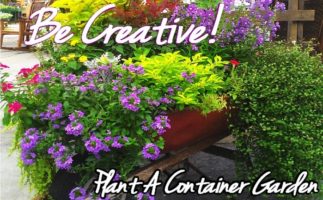Container Gardens are extremely popular for their instant beauty, ease of growing and versatility.
Planting in the ground can sometimes feel like work. But planting container gardens is just plain fun. Container gardens are relatively easy – just a few basic things to remember.
1. Selecting a container – A good rule is that larger is better. A larger container will hold more soil so it won’t dry out as fast. A heavy container may be necessary to keep it from blowing over. Beautiful pottery helps accent the plants and can be used year after year. An easy trick is to use a basic plastic container to put inside the beautiful pottery so that it’s easier to plant and move if necessary.
2. Drainage –Water must be able to drain out of the container. No exceptions. If the container doesn’t have holes / enough holes, you must add them. The holes need to be a min. of ¾” in diameter. It’s also good to get the container up off the ground to help promote drainage.
3. Weight – For larger containers, you can use styrofoam or fake bottoms in the container so that it’s not as heavy and you use less soil. For smaller containers, you can add rocks or bricks to give it weight but make sure you leave enough room for plenty of soil.
4. Soil – Use a good, light soil. The roots need air or they suffocate so heavy garden soil / top soil is not recommended. A mixture of peat, perlite, coir is best. If water holding is important, add Soil Moist to your potting mix.
5. Fertilizer – Plants in a container can’t get the food they need from the ground so you have to add it. Mix in a complete or slow-release type fertilizer as you plant or you may wish to fertilize with a water-soluble type once every two weeks. A combination of these two is preferable. Annuals are heavy feeders.
6. Plant selection – It’s common to think in terms of thrillers, fillers and spillers in containers. Thrillers are the tallest and add drama. Fillers go around the middle and add color. Spillers fall out of the side of the container and add interest and/or color. Most plants work in containers including perennials but remember that perennials are not likely to overwinter if left in a container above the ground. Select plants based on the sun / shade requirements, height, texture and your preference. Remember to leave room for the plants to get to their mature size.
7. Colors – Monochromatic containers and single plant patio pots tend to be more formal looking and can be seen from further away. Mixed colors tend to be more whimsical and creative. Contrasting colors can be dramatic. Every color brings emotion (red -wild, white –peace, yellow – happy, blue – rich) Some people like to match the color of plants to the house. There is no right or wrong so plant what appeals to you.
8. Planting – Test the position of the plants while still in their pots. Move them around until you like their arrangement. If the container will have a “back”, put the thriller plants in the back. If you want it symmetrical, put the thriller plants in the center. Fillers go in the middle and spillers on the side. Dig a a little bigger than the root of the plant and deep enough for the plant to have a solid foundation but not above the current soil line. Backfill with the planting mix and press firmly around the plant.
9. Watering – Water generously when first planted / first week or so to get them settled. Water when dry to the touch from then on. This could be daily or weekly depending on the weather. When you do water, water thoroughly (until the container starts to drip through the bottom) and then let dry to promote healthy roots. Watering in the morning is best. To prevent splitting, water from the side or underneath the foliage.


